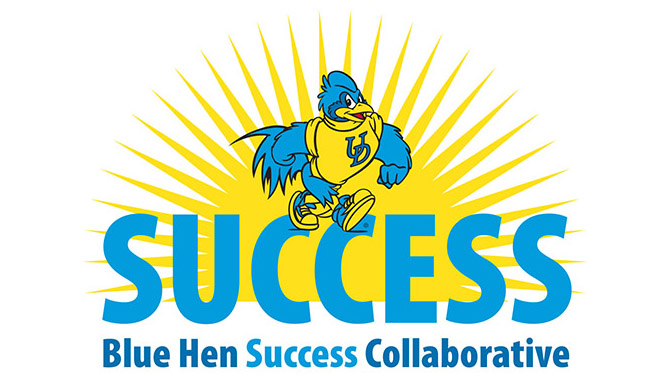


Keeping students on track
May 26, 2016
New system expected to improve student success
College students can fall off track academically for any number of reasons: not being ready for college, staying too long in the wrong major, getting poor grades in an introductory course, taking unnecessary classes, or waiting too long to take a critical course. For some, this may mean dropping out at some point during their college career and failing to get a degree.
Advisers and faculty at the University of Delaware are now armed with a powerful new system to help them quickly identify students who are struggling and help them stay on track to graduation. Called the Blue Hen Success Collaborative, the system uses a combination of predictive analytics, real-time data, consulting and networking to help advisers recognize and intervene with at-risk students.
“As a learner-centered university, we have a steadfast commitment to student success,” said Domenico Grasso, UD provost. “Research and innovation are at our core, so we are excited to be able to pair the power of big data with best practices in student advising.”
“The Blue Hen Success Collaborative is transformative,” said Chris Lucier, vice president for enrollment management. “It will have a major impact on the work we do to support our undergraduate students from initial enrollment to graduation, increasing retention and graduation rates for all students, particularly those who are from underrepresented and underserved populations.”
Along with Deputy Provost Lynn Okagaki, Lucier is leading the implementation of the collaborative with the help of a leadership team of associate deans, professional advisers and faculty representing all seven colleges and the registrar’s office. The system will roll out over the next three to four semesters, beginning with professional advisers and select faculty advisers piloting the program this fall.
Developed in 2013 by the Education Advisory Board (EAB), the Student Success Collaborative now boasts more than 200 higher education members, including Indiana University Bloomington, Ohio State University, Miami University, Clemson University and SUNY-Stony Brook University.
While UD’s four-year graduation rate of 70 percent is well above the national average, the University wants to do better. UD’s goal is to improve not only the overall graduation rates, but also those for underrepresented and underserved populations, which lag behind. The four-year graduation rate for underrepresented students is 10 percentage points below the overall group; Pell Grant recipients trail 9 percentage points behind; and first-generation students lag 7 percentage points behind.
Another important target group comprises students who may become at-risk later on, and in less obvious ways. EAB calls this group “the murky middle.” These students finish their first year with a grade point average between 2.0 and 3.0 and may not even realize they are headed off track. Perhaps they have gotten a C in a class and think they are doing OK, when in fact they really needed an A or B in that class to develop the foundational knowledge to succeed in their major.
Some students in the “murky middle” will go on to graduate, and some will not. Analyses of data provided by the collaborative can help separate out the at-risk students and target intervention efforts.
“The Blue Hen Success Collaborative will help us identify a hidden population of struggling students. We will be able to focus, coordinate and integrate our support and help students make good decisions before they may even realize they need help,” said Lucier.
The collaborative will provide UD customized analytics that identify the largest and most addressable pockets of risk unique to the University.
At a more granular level, relying on 10 years of UD’s own historical data, the analytics can suggest patterns in student behavior, such as what courses are problematic for which students, what is the expected likelihood of success for students who perform at certain levels in specific courses or majors, and what other options are suitable for students based on their current performance.
“The goal of the Blue Hen Success Collaborative is to improve the effectiveness and efficiency of advising interactions for all our students,” said Okagaki. “Providing quick access to critical information and an intuitive interface, we can save faculty and adviser time, allowing them to focus on improving student success.”
Real-time data will alert advisers to an individual’s problematic behavior — such as registering for the wrong course or declaring an unsuitable major, dropping a class or sudden dips in grades — and provide a risk assessment. The platform can identify some 800 discrete problems, prompting more frequent, meaningful conversations with advisers.
In these ways, the collaborative can also provide valuable curricular guidance. John Pelesko, associate dean in the College of Arts and Sciences, is enthusiastic about its potential to give department chairs clear information about how their courses and programs are impacting students and where the stumbling blocks are.
Aside from providing direct assistance, advisers will be able to use the system to guide students to the appropriate support services — such as tutoring, financial aid or counseling — which can sometimes be difficult to navigate.
Learn more
Lucier, Okagaki, and Pelekso will be presenting more information about the Blue Hen Success Collaborative at the Summer Faculty Institute on June 2.
About EAB
According to its website, the Washington-based Education Advisory Board, established in 2007, is a trusted adviser and performance improvement partner to 1,000-plus colleges and universities across North America and Europe. Whether through best practice research, data analytics, technology, or consulting services, its 650-plus researchers, consultants, engineers, and data scientists work with members every day to make higher education smarter.
Contact Us
Have a UDaily story idea?
Contact us at ocm@udel.edu
Members of the press
Contact us at mediarelations@udel.edu or visit the Media Relations website

